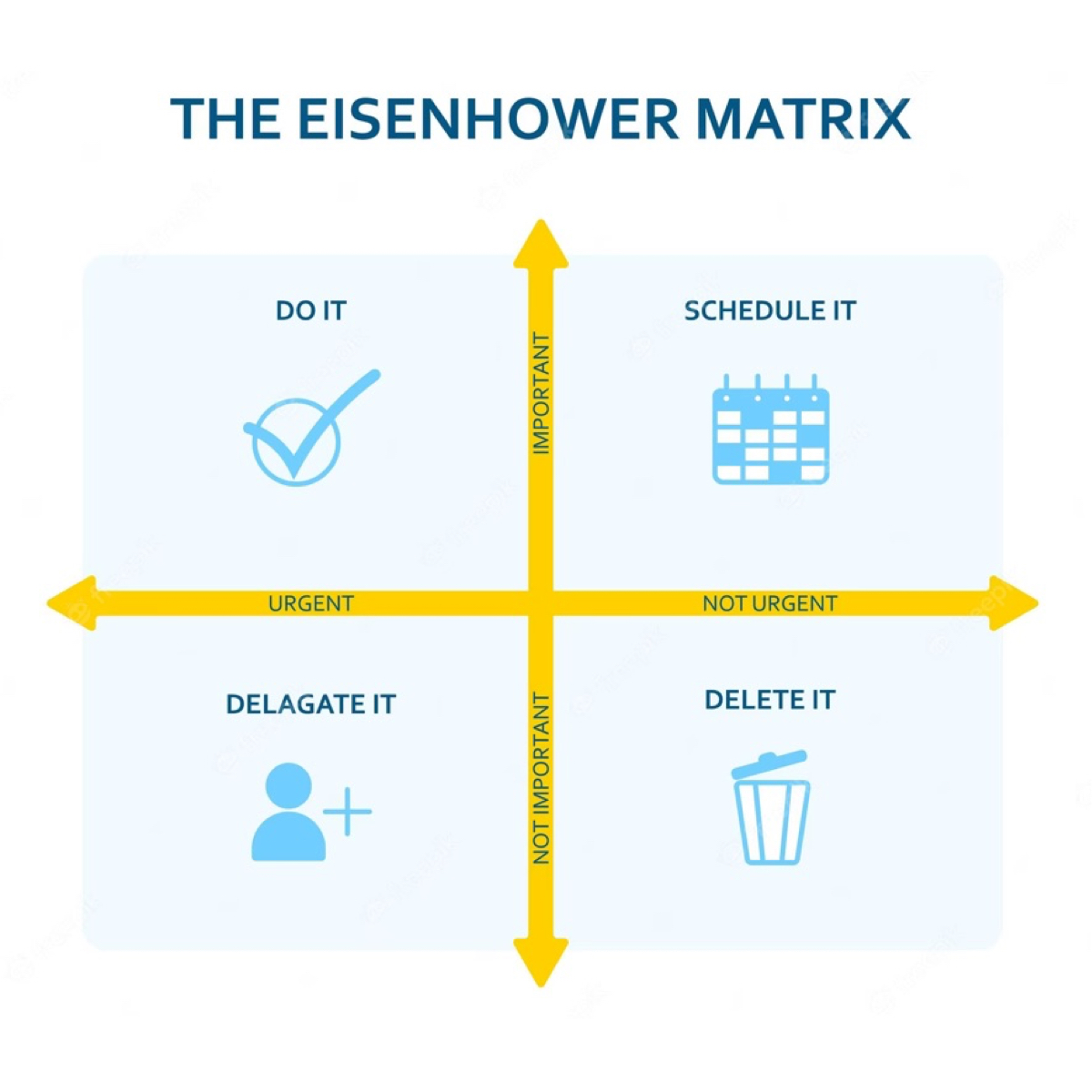
06 Aug The Eisenhower Matrix: 4 Amazing Steps to Prioritizing Your Time and Tasks
The Eisenhower Matrix: The Key to Prioritizing Your Time
In today’s world, where multitasking and constant busyness are often seen as indicators of productivity, time management is an essential skill. Without a clear strategy, we can find ourselves overwhelmed, underproductive, and unsatisfied. One method that has proven effective in managing time and increasing productivity is the Eisenhower Matrix.
Named after its founder, Dwight D. Eisenhower – the 34th President of the United States, the Eisenhower Matrix, also known as the Eisenhower Box or Eisenhower Decision Matrix, is a straightforward tool for sorting tasks based on their importance and urgency.
The Background
Before serving as the President, Eisenhower was a five-star general in the United States Army and served as the Supreme Commander of the Allied Expeditionary Forces during World War II. Over his career, he was consistently faced with tough decisions that had far-reaching implications. Out of these experiences, he developed the concept that is now known as the Eisenhower Matrix.
Eisenhower famously said, “What is important is seldom urgent, and what is urgent is seldom important.” This principle is the underlying philosophy of the Eisenhower Matrix.
What is Eisenhower Matrix?
The Eisenhower Matrix is a simple 2×2 grid that categorizes tasks along two axes: urgency and importance. This creates four quadrants:
Quadrant I: Important and Urgent
These are tasks that need to be dealt with immediately. They are often crises or problems, such as deadlines or urgent issues that must be addressed right away.
Quadrant II: Important but Not Urgent
Tasks in this category are those that contribute to long-term goals and personal growth. They may not have an immediate deadline, but they are essential for sustained success.
Quadrant III: Not Important but Urgent
These are tasks that demand your attention now, but don’t necessarily contribute to your goals or long-term success. They can be interruptions or distractions that should ideally be delegated if possible.
Quadrant IV: Not Important and Not Urgent
These are tasks that provide little to no value. They are often time-wasters and should be eliminated as much as possible.
Applying the Eisenhower Matrix
Step 1: List Your Tasks
Begin by listing all of the tasks that you need to complete. This could include personal tasks, work tasks, long-term goals, and short-term chores.
Step 2: Assign Each Task to a Quadrant
Next, evaluate each task’s urgency and importance. Urgent tasks require immediate attention, while important tasks contribute to your long-term goals, values, and mission. Once you’ve decided where a task belongs, place it in the corresponding quadrant.
Step 3: Determine Action for Each Quadrant
For each quadrant, a specific action should be taken:
- Quadrant I: Do – These tasks should be done as soon as possible.
- Quadrant II: Plan – Schedule a time to do these tasks, as they are important for your long-term goals.
- Quadrant III: Delegate – If possible, delegate these tasks to others.
- Quadrant IV: Eliminate – These tasks should be eliminated as they are not productive.
The Power of the Eisenhower Matrix
The beauty of the Eisenhower Matrix lies in its simplicity. By categorizing tasks into four distinct quadrants, it allows for a clear view of what truly matters. Using this system, you can better manage your time, reduce stress, and increase productivity.
The Eisenhower Matrix isn’t just about doing things right, but more importantly, doing the right things. It helps to filter out the noise, focus on what’s truly meaningful, and make decisions that align with your goals.
In conclusion, the Eisenhower Matrix is a timeless tool that empowers you to prioritize, take control of your time, and ultimately achieve success in a way that aligns with your long-term vision and values.
Examples of task prioritization using the Eisenhower Matrix.
Eisenhower Matrix for a software development project
Certainly, let’s consider a software development project and categorize tasks into the four quadrants of the Eisenhower Matrix.
- Quadrant I: Important and Urgent
- Fixing critical bugs affecting the system’s performance.
- Addressing security vulnerabilities discovered in the code.
- Meeting a regulatory compliance deadline that’s coming up soon.
- Quadrant II: Important but Not Urgent
- Writing comprehensive documentation for future code maintenance.
- Investing in skills development and learning new technologies.
- Refactoring code to improve overall system performance.
- Developing new features that are crucial to the product’s long-term success.
- Quadrant III: Not Important but Urgent
- Responding to emails and messages that demand immediate attention but are not directly related to project progress.
- Attending meetings that do not contribute significantly to the project’s advancement.
- Handling minor user interface changes requested by a client, which could be handled by a junior developer or a different team.
- Quadrant IV: Not Important and Not Urgent
- Spending time on unproductive meetings.
- Excessive social media browsing or non-work-related internet use during work hours.
- Perfecting code that already meets requirements and does not impact performance significantly.
Eisenhower Matrix for a school project
Let’s consider a school project and distribute tasks into the four quadrants of the Eisenhower Matrix.
- Quadrant I: Important and Urgent
- Completing the research section of the project due to an approaching deadline.
- Writing and rehearsing the presentation for the project if it is to be presented soon.
- Solving any pending problems or issues with the project that could hinder its completion or its final grade.
- Quadrant II: Important but Not Urgent
- Reviewing and editing the project to improve its overall quality.
- Planning ahead for any materials or resources needed for project completion.
- Studying related topics to gain a deeper understanding and enhance the project’s quality.
- Quadrant III: Not Important but Urgent
- Addressing unrelated school administrative tasks or assignments that are due soon but don’t directly affect the project.
- Attending club meetings or extracurricular activities that require your immediate attention but are not essential for your project.
- Responding to non-project-related emails or messages that demand immediate attention.
- Quadrant IV: Not Important and Not Urgent
- Spending excessive time on perfecting project elements that are already acceptable and do not significantly impact the final grade.
- Constantly checking social media or engaging in other digital distractions.
- Participating in optional social events that don’t contribute to your academic goals or project success.
Example of Eisenhower Matrix for a home remodeling project
let’s consider a home remodeling project and sort tasks into the four quadrants of the Eisenhower Matrix.
- Quadrant I: Important and Urgent
- Hiring a contractor or finalizing DIY plans if the project’s start date is quickly approaching.
- Dealing with immediate structural issues, like a leaky roof or a broken pipe.
- Securing necessary permits if work is scheduled to start soon.
- Quadrant II: Important but Not Urgent
- Researching and selecting materials, furniture, and appliances to fit the remodeling vision and budget.
- Creating a detailed project timeline to manage work efficiently and minimize disruptions.
- Building a contingency plan and budget for unexpected issues or costs.
- Visiting showrooms or meeting with an interior designer to finalize design plans.
- Quadrant III: Not Important but Urgent
- Responding to a sales offer from a supplier that doesn’t fit into your remodeling plans but needs an immediate reply.
- Attending to small home maintenance tasks that aren’t related to the remodeling but demand immediate attention.
- Managing distractions like unscheduled calls from contractors or suppliers.
- Quadrant IV: Not Important and Not Urgent
- Spending time on minor details that don’t significantly impact the overall project.
- Browsing through countless design options beyond what’s necessary for inspiration.
- Watching excessive home remodeling shows that don’t contribute directly to the progress of your project.





